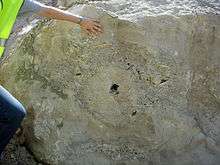Thrombolite


Thrombolites are ancient forms of microbial communities that photosynthesize. They are clotted accretionary structures formed in shallow water by the trapping, binding, and cementation of sedimentary grains by biofilms of microorganisms, especially cyanobacteria. They are now only found in a few places in the world. Stromatolites are similar but consist of layered accretions. The ancestors of thrombolites and stromatolites are thought to have contributed to the increase in oxygen in Earth's atmosphere.
Structure
Thrombolites have a clotted structure which lacks the laminae of stromatolites and each clot within a thrombolite mound is a separate cyanobacterial colony.[1] The clots are on the scale of millimetres to centimetres and may be interspersed with sand, mud or sparry carbonate.[1] The larger clots make up more than 40% of a thrombolite's volume and each clot has a complex internal structure of cells and rimmed lobes resulting primarily from the in situ calcification of the cyanobacterial colony. Very little sediment is found within the clots as the main growth method is calcification rather than sediment trapping.[1]
References
External links
| Wikimedia Commons has media related to Thrombolites. |